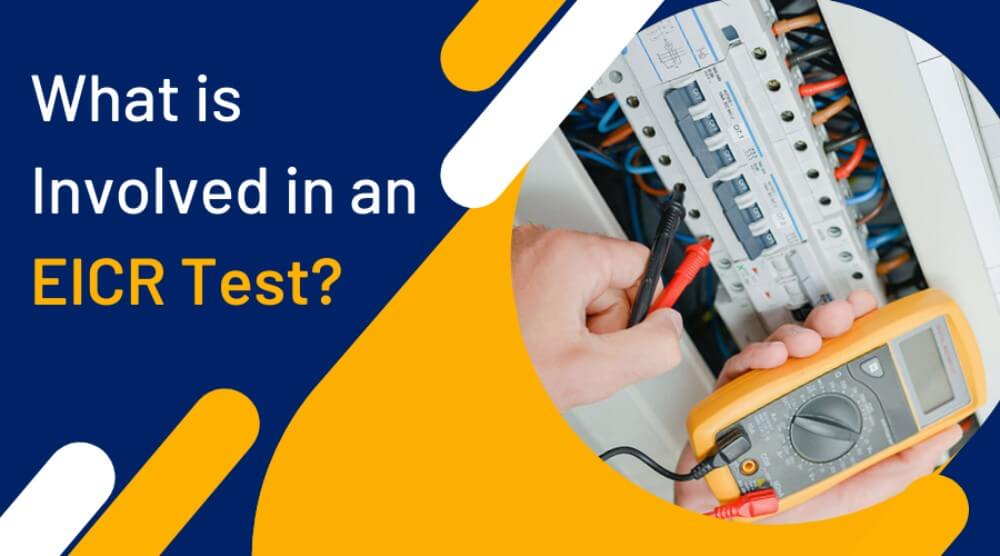To begin, let us explain what an EICR is and what it does. An EICR (Electrical Inspection Condition Report) is an official document created after a complete examination of electrical installations in any residential, commercial, or industrial property. We will provide an in-depth analysis of electrical systems and facilities to detect degradation or defects. Following the completion of the evaluation, a report will be given highlighting any deficiencies in electrical systems compared to the UK standard for safety installations – BS7671 Requirements for Electrical Installations (IET Wiring Regulations).
So, what exactly is an EICR test? Only a highly qualified, professional, and experienced electrician can perform an EICR test. The electrician must disconnect the electricity from the primary power source before performing the test. They will then analyse the status of the electrical system and assess it for safety and compliance during the trial, giving special attention to any degradation or problems. They will then inspect the electrical system under the UK Standard for the Safety of Electrical Installations regulation.
After completing the assessment, the electrician will provide you with a report, and any faults/noncompliances within the electrical system will be mentioned in the report, together with the explanation for the failure, if applicable, and evaluated in terms of their danger under EICR fault codes. Please remember that many defects cannot be seen with the naked eye and are only detected during an EICR test. When the electrical system has fully passed inspection, and any critical repair work has been completed, an adequate EICR can be issued to prove the security of the electrical facilities.
The Components of an EICR
The report is divided into sections that the examining electrician must fill out in detail. The first section of the certificate includes information on the client/installation, the inspection’s objective, scope, and limitations, and a summary of the results.
The inspector will then write down their recommendations for the next steps, including the applicable EICR code for each issue (see section below) and whether more investigation is necessary.
- Electrical supply characteristics and earthing configurations
- Installation specifics at the point of origin (such as means of earthing, circuit breaker details etc.)
- A distribution board and circuit inspection schedule
- Specifications of the test instruments utilised
- Measurements of the distribution board
The Meaning of EICR Codes
The EICR codes in the report’s recommendations section and inspection schedules are used to identify the amount of risk associated with a specific item and the action that the issue poses to a tenant or an electrician carrying out repairs. There are three types of codes:
- C1 – a threat exists that poses a risk of injury (immediate action is required)
- C2 – a possible danger exists (urgent action is required)
- C3 – improvement is suggested
Using EICR Codes
Inspectors should code items on the schedule using the most recent edition of the wiring regulations. When reporting the safety of metering equipment at a site, the inspector should refer to the wiring regulations to establish whether the metering at the premises meets the most current standards.
The C1 and C2 codes indicate that the property owner requires legal action and should be kept for specific situations. Use a C2 code when you detect something that could become a hazard due to a flaw or an unexpected incident. If any portion of the electrical infrastructure poses an urgent danger to anyone who uses it, then the tester will mark it with the C1 code.
C3 codes should be used when there is no imminent threat, but changes would result in considerable improvements to the safety of electrical infrastructure. Even though the installation does not meet the most current requirements, not all obsolete facilities require upgrading. According to the best practice guide for EICRs:
Existing installations built under prior editions of the Standard may not be fully compliant with the current edition, but this does not necessarily mean that they are unsafe for ongoing use or require modification.
Another thing to keep in mind about C3 codes is that the great majority of owners will not act based on a C3. As a result, use the C2 code rather than the C3 code if an electrical installation requires attention to avoid any potential hazards.
The Value of Correct EICR Codes
The electrical inspector is in charge of EICR codes assigned during inspections and what happens as a result. The codes are critical in ensuring that wiring is safe and does not endanger members of the public. While deciding which code to use can be challenging, the inspector must ensure they are entirely comfortable with it before submitting the report.
Clients frequently put pressure on electrical inspectors to downgrade an item from a C2 to a C3 so that they can avoid legal action and save money.
Similarly, some contractors are inclined to use C3s nearly universally in the hopes of retaining customers by lowering the amount of time they must spend on actioning EICR conclusions. While this may result in more revenue for you in the short term, the long-term effects could be disastrous. If property damage happens due to an inaccurate EICR, the inspector will be held liable for insurance claims; if anybody is wounded or killed as a result of misclassified electrical safety equipment, the inspector may face criminal charges.
Hopefully, after reading this assignment, you have a better understanding of what to expect and how to prepare to guarantee that your inspection and EICR test go off without a hitch.


























